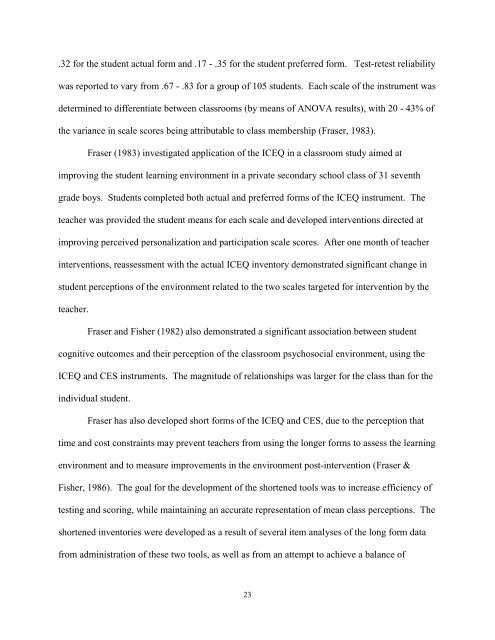STUDENT EVALUATION OF CLINICAL EDUCATION ENVIRONMENT
STUDENT EVALUATION OF CLINICAL EDUCATION ENVIRONMENT
STUDENT EVALUATION OF CLINICAL EDUCATION ENVIRONMENT
Create successful ePaper yourself
Turn your PDF publications into a flip-book with our unique Google optimized e-Paper software.
.32 for the student actual form and .17 - .35 for the student preferred form. Test-retest reliability<br />
was reported to vary from .67 - .83 for a group of 105 students. Each scale of the instrument was<br />
determined to differentiate between classrooms (by means of ANOVA results), with 20 - 43% of<br />
the variance in scale scores being attributable to class membership (Fraser, 1983).<br />
Fraser (1983) investigated application of the ICEQ in a classroom study aimed at<br />
improving the student learning environment in a private secondary school class of 31 seventh<br />
grade boys. Students completed both actual and preferred forms of the ICEQ instrument. The<br />
teacher was provided the student means for each scale and developed interventions directed at<br />
improving perceived personalization and participation scale scores. After one month of teacher<br />
interventions, reassessment with the actual ICEQ inventory demonstrated significant change in<br />
student perceptions of the environment related to the two scales targeted for intervention by the<br />
teacher.<br />
Fraser and Fisher (1982) also demonstrated a significant association between student<br />
cognitive outcomes and their perception of the classroom psychosocial environment, using the<br />
ICEQ and CES instruments. The magnitude of relationships was larger for the class than for the<br />
individual student.<br />
Fraser has also developed short forms of the ICEQ and CES, due to the perception that<br />
time and cost constraints may prevent teachers from using the longer forms to assess the learning<br />
environment and to measure improvements in the environment post-intervention (Fraser &<br />
Fisher, 1986). The goal for the development of the shortened tools was to increase efficiency of<br />
testing and scoring, while maintaining an accurate representation of mean class perceptions. The<br />
shortened inventories were developed as a result of several item analyses of the long form data<br />
from administration of these two tools, as well as from an attempt to achieve a balance of<br />
23












